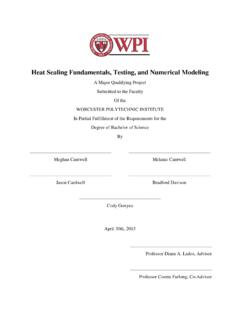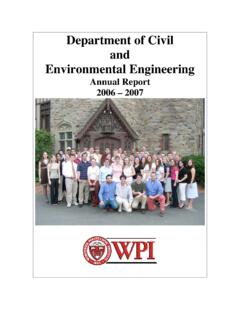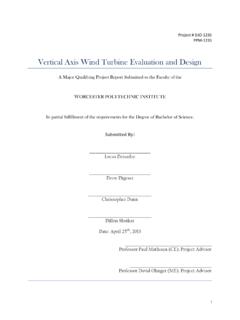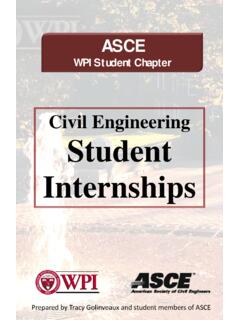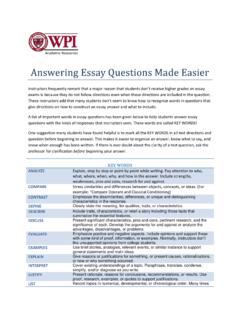Transcription of Designing a Headgear for Soccer
1 Designing a Headgear for Soccer A Major Qualifying Project submitted to the faculty of Worcester Polytechnic Institute in partial fulfillment of the requirements for the Degree of Bachelor of Science Submitted by: Isaac Barbour Nikole Connor Elisabeth Jeyaraj Submitted to: Professor Brian Savilonis 2011 - 2012 BJS - RE11 2 Abstract Participation in sports greatly increases the chance of concussion, and in a study on Soccer it was determined that of players experienced at least one concussion during a season. The goal of this project was to address existing gaps in the efficacy of available Soccer Headgear . Design considerations included reducing head accelerations during collisions, thermal regulation, and size adaptability, while not limiting the users mobility during game play. The Headgear reduced linear accelerations by an average of along the sagittal plane, and along the coronal plane, while only increasing head exterior temperature by F during exercise.
2 Feedback from university Soccer athletes showed positive results for comfort and fit. Overall, the prototype addressed the existing gaps in the effectiveness of competing products and met the team s objectives. Authorship Isaac Barbour, Nikole Connor, and Elisabeth Jeyaraj contributed equally to the completion of this Major Qualifying Project and report. The team would like to thank Donald Pellegrino, Russell Lang, and Professor John Hall for their lab assistance and engineering expertise. Additional thanks to Rogers Corporation for their material donations and The Hartford Science Center for allowing use of their Helmet Crash Test exhibit. Final thanks to our advisor, Professor Brian Savilonis, who helped make this project a success. 3 Table of Contents Abstract .. 2 Authorship .. 2 Table of Contents .. 3 Table of Figures .. 5 Table of Tables .. 6 Chapter 1: Introduction .. 7 Chapter 2: Background.
3 8 Concussions: An 8 Physiology .. 8 Mechanics .. 9 Biomechanical Factors for Brain Injury .. 10 Modeling of Concussion .. 10 Concussions in sports .. 13 Causes .. 13 Symptoms .. 14 Protocol after a 14 Reoccurring Concussions .. 15 Headgear in 15 Physical Characterization of helmets and Headgear .. 15 Related products in contact sports .. 16 Current products for Soccer .. 16 Initial Client Statement .. 19 Chapter 3: Design Parameters ..20 Objectives .. 20 Functions .. 22 Means .. 23 Specifications .. 23 Constraints .. 24 Revised Client Statement .. 24 Chapter 4: Methodology ..25 Conceptual Design .. 25 Needs Analysis .. 25 Preliminary Design Alternatives .. 25 Choosing a design .. 29 Final Design Description .. 30 Construction and Testing Procedures .. 31 Material Selection .. 31 Headgear Construction .. 32 Experimentation for Constructed Design .. 33 4 Design Validation and Review .. 37 Chapter 5: Results and Discussion.
4 39 Foam Shock 39 Wicking Material .. 45 Swinging Arm Crash 45 Acceleration Ramp 47 Design Validation and Review - Analysis .. 52 Chapter 6: Conclusion ..55 Chapter 7: Future Recommendations ..56 References ..57 Appendix A: Interviews with Stakeholder minutes ..61 Coach Malcolm Macpherson September 9th, 2011 .. 61 Interview with F90 Headguard users: September 23th, 2011 .. 61 Interview with the Women s Soccer Team Captains: September 16th, 2011 .. 62 Interview with Dr. J. H. Stevenson September 16th, 2011 .. 63 Interview with Professor Satya Shivkumar October 1st, 2011 .. 65 Appendix B: Patents of Soccer Headgear ..67 Appendix C: Annotated Bibliographies for Head Modeling ..69 : Model 1 Zhang, King and Albert .. 69 : Model 2 Arakere, Grujicic and He .. 70 : Model 3 Akkas .. 71 : Model 4 Ljung .. 72 Appendix D: IRB Survey Questions ..74 5 Table of Figures Figure 1: Neurometabolic Cascade over time .. 9 Figure 2: Model of Predicting Concussion.
5 12 Figure 3: A Typical Football Helmet .. 15 Figure 4: A Typical Rugby Scrum Cap .. 15 Figure 5: The F90 Premier Headgear for Soccer .. 15 Figure 6: A. The Full 90 Headgaurd; B. the Headblast; C. The Protector .. 17 Figure 7: Full 90 Headguard: Side View .. 18 Figure 8: Objective Tree .. 20 Figure 9: Design Alterative 1 .. 26 Figure 10: Design Alterative 2 .. 26 Figure 11: Design Alterative 3 .. 27 Figure 12: Design Alterative 4 .. 27 Figure 13: Design Alterative 5 .. 28 Figure 14: Design Alterative 6 .. 28 Figure 15: Isometric View of Headgear .. 30 Figure 16: Trimetric View of the Back of the Headgear .. 30 Figure 17: Instron Dynatup 8254 .. 31 Figure 18: Constructed Headgear .. 33 Figure 19: Poron Dimensions for Prototype .. 33 Figure 20: Crash Test Apparatus .. 34 Figure 21: Kinematics Equations to Determine Ramp Length .. 34 Figure 22: Constructed Ramp and Cart .. 35 Figure 23: Wiring for Power and Output .. 36 Figure 24: Basic Wiring Diagram .. 36 Figure 25: Labview Block Diagram.
6 37 Figure 26: Force vs. Time of the Stainless Steel Plate (control) .. 40 Figure 27: Poron 1/4 inch: A Test 1; B Test 2 .. 41 Figure 28: Poron 3/8 inch: A Test 1; B Test 2 .. 42 Figure 29: Poron 1/2 inch: A Test 1; B Test 2 .. 43 Figure 30: Impaxx 1/4 inch Tests .. 44 Figure 31: Impaxx 3/8 inch Tests .. 44 Figure 32: Impaxx 1/2 inch Trials .. 44 Figure 33: Acceleration vs. Distance .. 46 Figure 34: Acceleration vs. Time at (Control): A Trial 1; B Trial 2; C Trial 3 .. 48 Figure 35: Acceleration vs. Time at ( Headgear ): A Trial 1; B Trial 2; C Trial 3 .. 49 Figure 36: Acceleration vs. Time at ft (Dual Headgears): A Trial 1; B Trial 2; C Trial 3 .. 51 Figure 37: Peak Accelerations from .. 51 Figure 38: Infrared reading of Male 5 back and side view .. 53 6 Table of Tables Table 1: Material Properties used in the 12 Table 2: Peak Force, Time to Peak Force and Impulse (Mean SD) (Broglio et al. 2003) .. 17 Table 3: Head Injury Indices With and Without Headgear (Lehner et al.)
7 2010) .. 18 Table 4: First Level Pairwise Comparison Chart .. 21 Table 5: Second Level Pairwise Comparison Chart for the objective "Effective" .. 21 Table 6: Third Level Pairwise Comparison Chart for the objective User Friendly .. 22 Table 7: Morphological chart .. 25 Table 8: Numerical Evaluation Matrix .. 29 Table 9: Material Impact Results .. 39 Table 10: Cotton and Capilene Evaporation Rate .. 45 Table 11: Linear Accelerations (g) .. 46 Table 12: Quantitative Survey Data Analysis .. 52 Table 13: Temperature of the Side of the Head during Rest and After Exercise .. 53 Table 14: Temperature of the Back of the Head during Rest and After Exercise .. 54 Table 15: Surface Temperature of the side and back of the Headgear before and after exercise .. 54 7 Chapter 1: Introduction Approximately 225,000 new patients per year suffer from a concussion, which is a mild form of traumatic brain injury (TBI) that is caused by a bump, blow, or jolt to the head (Delany et al.
8 2002; A Fact Sheet for Teachers, Counselors, and School Professionals 2010). The severity of the concussion is dependent upon rotational or linear forces that result in acceleration and deceleration of the brain around the midpoint. Observational symptoms include headache, nausea, balance issues, noise sensitivity, confusion, and potentially a loss of consciousness ( A Fact Sheet for Teachers, Counselors, and School Professionals 2010). Concussions can also cause neurological injury, including brain bruising and cell death (Patlak 2002). These injuries to the brain can be especially detrimental to collegiate athletes under the age of 20 because the player s brain is still in the developing stages. Participation in sports increases the risk of a mild TBI or concussion. In a specified study by Delany, of Soccer players experienced at least one concussion. In this same study, only of the had even realized they had a concussion.
9 Of the concussed players, experienced symptoms for at least a week (Delany et al. 2002). Once an athlete suffers from a concussion, they are three times more likely to get another concussion (Guskiewicz, McCrea, and Marshall 2003). The growing number of concussions shows that there is a need for Headgear that can help alleviate concussion-causing forces. Helmets and Headgear are prevalent throughout all contact sports, except Soccer . However, within the past ten years, there has been a development of Headgear designs specifically for Soccer , and many of these designs were meant to address different aspects of Soccer related brain injury. One of the major products on the market, the Full90 Headguard, has attempted to address some of the issues stated above ( F90 Premier Headguard 2011). However, studies show that it does not reduce enough acceleration to be considered extremely helpful. Therefore, further developments necessary for an effective Soccer Headgear .
10 Through literature research and stakeholder interviews, it was determined that the existing products were not completely satisfying the user needs. The current designs are not thermally regulated, making the athlete uncomfortably warm during play. Additionally, the designs do not conform to the shape of the player s head, resulting in constant adjustment, which interferes with play. These gaps in the Soccer Headgear designs have created a need for an innovative product. Observing the shortcomings of the current products on the market, and identifying the technological breakthroughs, the team has investigated means to prevent concussion-causing accelerations through the use of a Headgear design. 8 Chapter 2: Background Concussions: An Overview Participation in sports greatly increases the chance of a concussion, which occurs during head collisions. In this section of the background, the physiology of the brain and the effects of different forces on the brain will be further explored.
